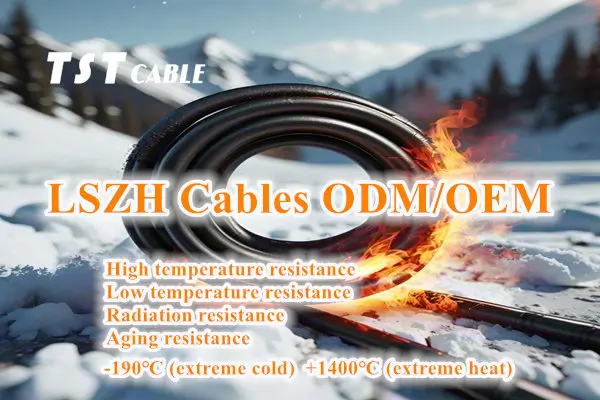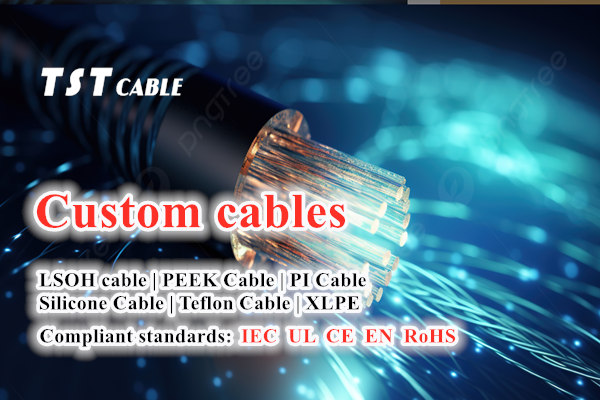The Electromagnetic Compatibility (EMC) test methodology for EN 50264 cables involves a series of steps and test items to ensure that the performance of the cables in an electromagnetic environment complies with the relevant standards and requirements. The following is a general methodology for EN 50264 cable EMC testing by TST CABLES:
EN 50264 cable electromagnetic compatibility (EMC) test method steps:
I. Preparation
- Test Sample Preparation: Select the cable samples that meet the EN 50264 standard, to ensure that the sample length, cross-section, material, etc. to meet the test requirements.
- Test environment preparation: select the test site in line with EMC test standards, to ensure that the electromagnetic interference level of the test environment is low, and to meet the temperature and humidity requirements for testing.
- Test equipment preparation: Prepare the necessary test equipment, such as spectrum analyzer, signal generator, antenna, impedance stabilization network (LISN), etc., and carry out calibration to ensure the accuracy of the test results.
II. Conducted Emission Test
- Connect the test equipment: Connect the cable samples to the LISN to ensure a good and stable connection.
- Setting test parameters: according to EN 50264 standard, set parameters such as frequency range and output power of the signal generator.
- Make measurements: Turn on the signal generator and record the conducted emission data on the spectrum analyzer. Perform measurements at different frequency points to obtain complete conducted emission characteristics.
测试-1024x505.png)
III. Radiated Emission Test
- Lay out the test site: Lay out the antenna in the test site and make sure the distance and angle between the antenna and the cable sample meet the test requirements.
- Setting test parameters: According to EN 50264 standard, set the parameters such as frequency range and output power of the signal generator.
- Make measurements: Turn on the signal generator and record the radiation emission data received by the antenna.
Make measurements at different frequency points to get the complete radiated emission characteristics.
测试2-1024x557.png)
IV. Immunity Test
- Setting up the interference source: According to EN 50264 standard, choose a suitable interference source (e.g. pulse generator, continuous wave interference source, etc.) and set up the corresponding parameters.
- Connect cable samples: Connect the cable samples to the test equipment and make sure the connection is normal.
- Apply interference: Turn on the interference source and apply interference signal to the cable sample.
- Observe the test results: Observe the performance of the cable samples under interference, such as signal loss, BER, etc.
V. Data Analysis and Report Writing
Data organization: Organize and analyze the data recorded during the test to extract key information.
- Judgment of results: Judge whether the EMC of the cable sample is qualified according to the requirements of EN 50264 standard.
- Report preparation: Prepare a detailed test report, including test methods, test conditions, test data, and judgment of results.
It should be noted that the specific test methods and procedures of TST CABLES may vary depending on different cable types, application environments and standard requirements. Therefore, you should carefully review the relevant standards and specifications to ensure that you follow the correct methods and steps when performing EMC testing of EN 50264 cables.
Example of a sample Electromagnetic Compatibility (EMC) test for EN 50264 cables:
EN 50264 Combustion test for cables with wall thickness in bundles
Cable bundle combustion test method according to EN 50266-2-4 for cables with a diameter greater than or equal to 12 mm.
Cables with a diameter greater than 6mm and less than 12mm are tested according to 9.1.1 of the EN 50305 standard. The standard requires that the length of burning damage to the cable does not exceed 2.5 meters.
Cables with a diameter of up to 6 mm are tested according to 9.1.2 of the EN 50305 standard. The standard requires the cable to have a burning damage length of not more than 1.5 meters.
EN 50264 Test for smoke release from cables:
Tested according to EN 50268-2, the percentage of light transmission shall not be less than the following values for rolling stock and its basic installations, according to the EN 45545-1 standard for hazard classes.
HL1 hazard class with no requirement for light transmission of smoke emissions. HL2 and HL3 hazard classes with ≥ 60% light transmission of smoke emissions. HL4 hazard class with ≥ 70% light transmission of smoke emissions.
EN 50264 Toxicity test for cables:
- Tests are carried out according to EN 50305, item 9.2.The following values shall be applied for rolling stock and its basic facilities according to EN 45545-1 for the hazard classes.
- For hazard class HL1, the index of toxicity (ITC) is not specified.For hazard classes HL2 and HL3, the maximum value of the index of toxicity (ITC) must not exceed 5.For hazard class HL4, the maximum value of the index of toxicity (ITC) must not exceed 3.
For more information on low-smoke, halogen-free, flame-retardant, high-temperature-resistant cables or to customize cables for your machinery or system, visit https://www.tstcables.com/contact-us/
or send an e-mail to :lixiangchao@testeck.com.
Also available in:
English




